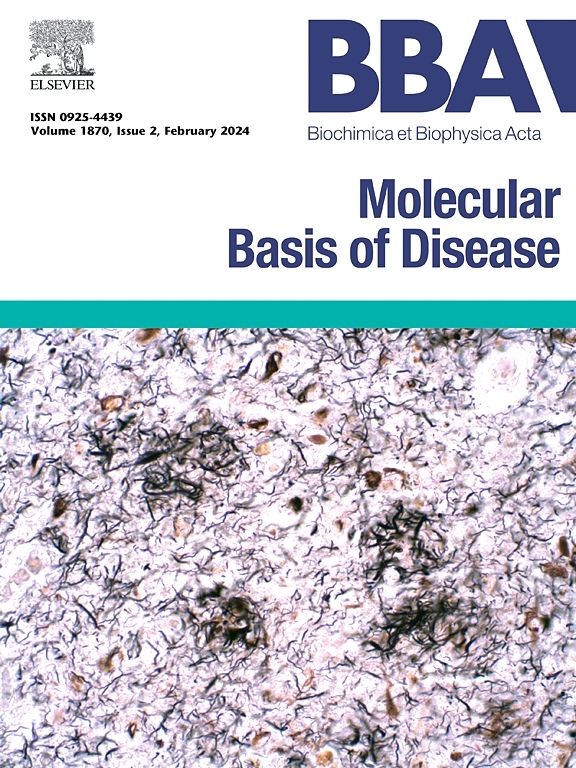Docosahexaenoic acid prevents peroxisomal and mitochondrial protein loss in a murine hepatic organoid model of severe malnutrition
IF 4.2
2区 生物学
Q2 BIOCHEMISTRY & MOLECULAR BIOLOGY
Biochimica et biophysica acta. Molecular basis of disease
Pub Date : 2025-04-29
DOI:10.1016/j.bbadis.2025.167849
引用次数: 0
Abstract
Introduction
Acute and chronic exposure of cells to low amino acid conditions have been shown to lead to a reduction in hepatic peroxisomal and mitochondrial content. There is limited understanding of the underlying mechanisms behind this loss, but data suggests degradation through autophagy. Both organelles play a key role in fatty acid metabolism, which may explain why dysfunction in either one of them might lead to hepatic steatosis.
Methods
Using a previously established murine hepatic organoid model of severe malnutrition, we characterized the effects of prolonged amino-acid restriction on peroxisomal and mitochondrial protein levels and on autophagic flux. To do so, we developed concatemers of 13C-labelled peptide standards for quantification of over 50 different peroxisomal proteins. To assess the autophagic flux, we transduced hepatic organoids with a GFP-LC3-RFP-LC3ΔG probe. Finally, the effect of PPAR-α activation on peroxisomal loss was determined with various agonists.
Results
Prolonged (96 h) amino-acid restriction led to a more severe loss of peroxisomes than a 48 h restriction, and with a substantial induction of autophagic flux. This was accompanied by accumulation of intracellular triglycerides, loss of mitochondrial and peroxisomal proteins, and loss of peroxisomal functionality. While PPAR-α agonists WY-14643 and linoleic acid (LA) had no effect, docosahexaenoic acid (DHA) supplementation partly prevented peroxisomal and mitochondrial loss under amino-acid restricted conditions and partly inhibited autophagy.
Discussion
The potential of DHA to prevent loss of peroxisomes and mitochondrial functions in low protein diets and severe malnutrition warrants further causal and translational testing in preclinical models and clinical trials, including its use as nutritional supplement.
二十二碳六烯酸在严重营养不良的小鼠肝类器官模型中防止过氧化物酶体和线粒体蛋白的损失
急性和慢性暴露于低氨基酸条件下的细胞已被证明会导致肝过氧化物酶体和线粒体含量的减少。对这种损失背后的潜在机制的理解有限,但数据表明通过自噬降解。这两种细胞器在脂肪酸代谢中都起着关键作用,这可以解释为什么它们中的任何一种功能障碍都可能导致肝脂肪变性。方法利用先前建立的严重营养不良小鼠肝类器官模型,研究了长时间限制氨基酸对过氧化物酶体和线粒体蛋白水平以及自噬通量的影响。为此,我们开发了13c标记肽标准的串联物,用于定量50多种不同的过氧化物酶体蛋白。为了评估自噬通量,我们用GFP-LC3-RFP-LC3ΔG探针转导肝类器官。最后,用各种激动剂测定PPAR-α活化对过氧化物酶体损失的影响。结果长时间(96 h)氨基酸限制导致过氧化物酶体的损失比48 h限制更严重,并显著诱导自噬通量。这伴随着细胞内甘油三酯的积累,线粒体和过氧化物酶体蛋白的丧失,以及过氧化物酶体功能的丧失。虽然PPAR-α激动剂y -14643和亚油酸(LA)没有作用,但二十二碳六烯酸(DHA)补充部分阻止了氨基酸限制条件下过氧化物酶体和线粒体的损失,部分抑制了自噬。DHA在低蛋白饮食和严重营养不良中预防过氧化物酶体和线粒体功能丧失的潜力值得在临床前模型和临床试验中进一步进行因果和转化测试,包括将其用作营养补充剂。
本文章由计算机程序翻译,如有差异,请以英文原文为准。
求助全文
约1分钟内获得全文
求助全文
来源期刊
CiteScore
12.30
自引率
0.00%
发文量
218
审稿时长
32 days
期刊介绍:
BBA Molecular Basis of Disease addresses the biochemistry and molecular genetics of disease processes and models of human disease. This journal covers aspects of aging, cancer, metabolic-, neurological-, and immunological-based disease. Manuscripts focused on using animal models to elucidate biochemical and mechanistic insight in each of these conditions, are particularly encouraged. Manuscripts should emphasize the underlying mechanisms of disease pathways and provide novel contributions to the understanding and/or treatment of these disorders. Highly descriptive and method development submissions may be declined without full review. The submission of uninvited reviews to BBA - Molecular Basis of Disease is strongly discouraged, and any such uninvited review should be accompanied by a coverletter outlining the compelling reasons why the review should be considered.

 求助内容:
求助内容: 应助结果提醒方式:
应助结果提醒方式:


